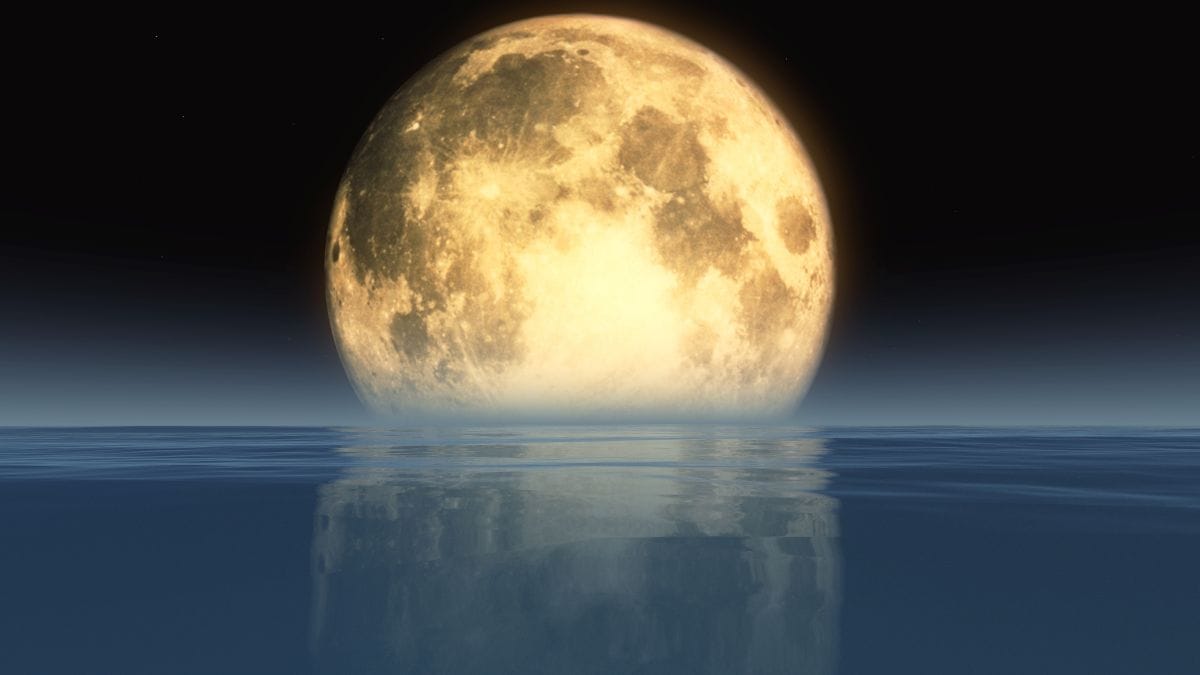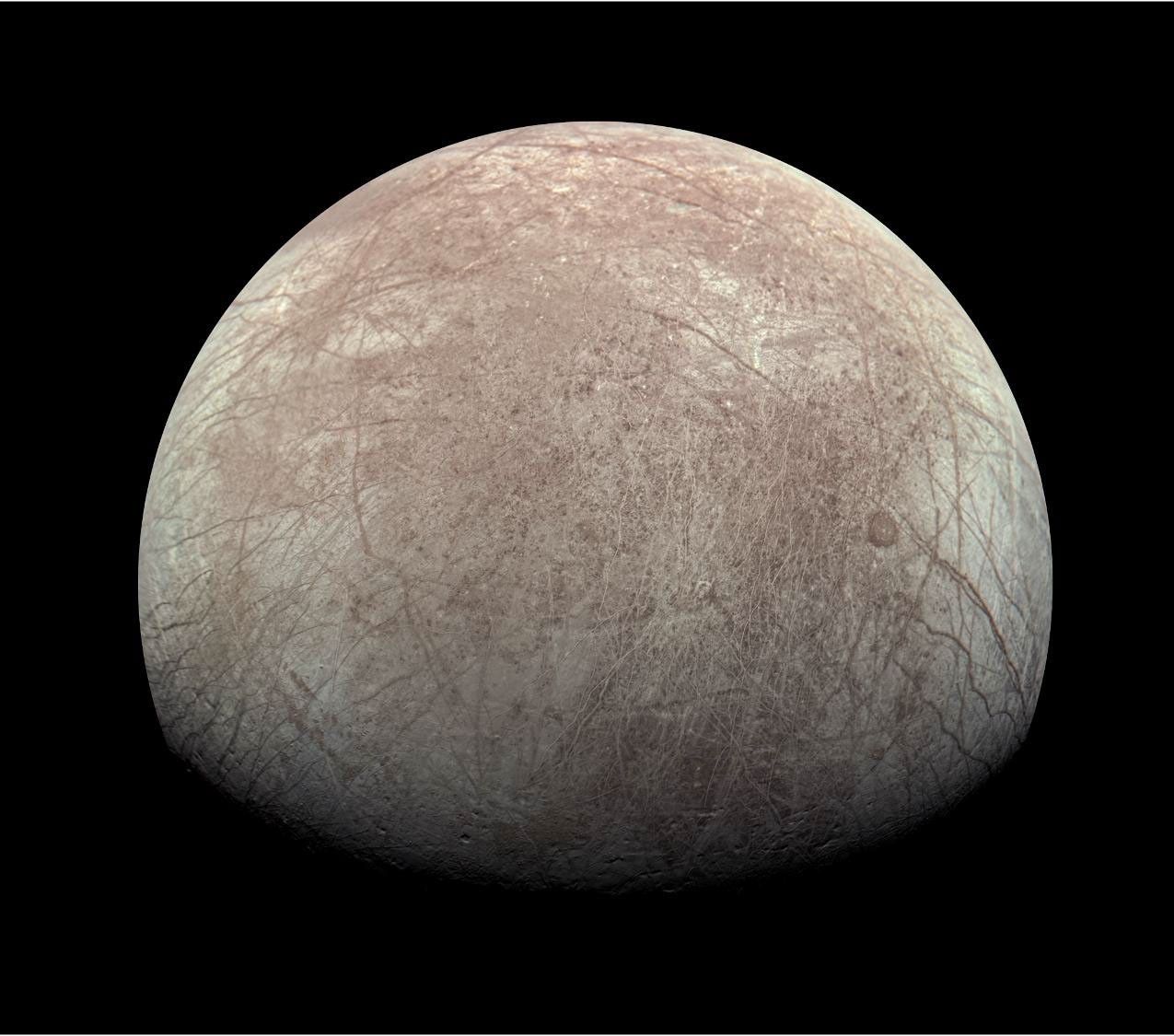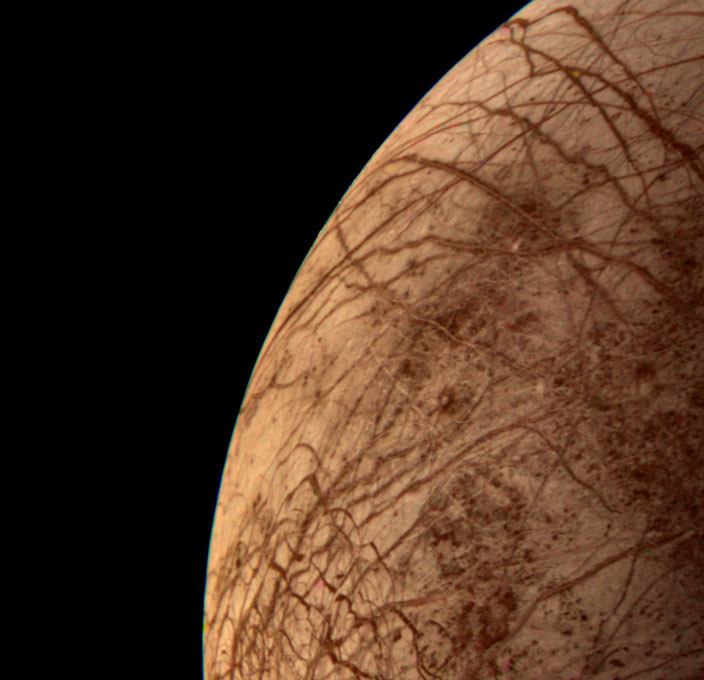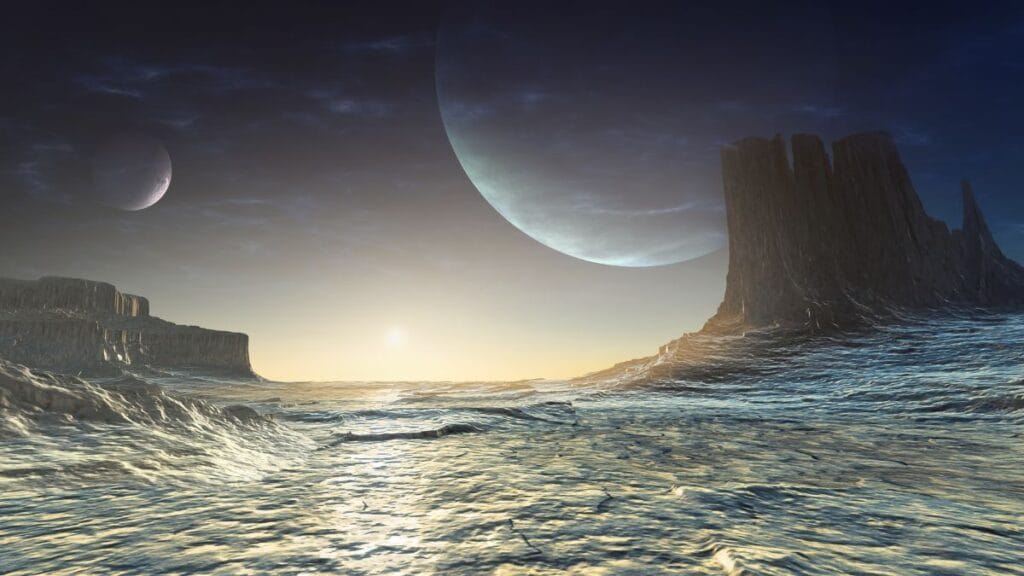
Imagine peering through a spacecraft’s camera at a distant moon, where plumes of water vapor shoot high into space from cracks in an icy surface, hinting at hidden depths teeming with possibilities. In our solar system, several moons harbor vast subsurface oceans beneath their frozen exteriors, making them prime targets for understanding how water persists far from the Sun’s warmth. Recent missions, like NASA’s Cassini spacecraft that flew by Saturn’s moon Enceladus in the early 2000s, revealed geysers erupting salty water particles, confirming a global ocean below the ice. Similarly, observations from the Hubble Space Telescope in 2015 showed evidence of an underground saltwater ocean on Jupiter’s largest moon, Ganymede, with more water than all of Earth’s oceans combined. These discoveries, updated through 2025 analyses, highlight how tidal forces and internal heat keep water liquid in unexpected places, challenging our views of where life-friendly environments might exist.
As scientists analyze data from ongoing probes, such as the Europa Clipper launched in October 2024, they uncover that these ocean worlds are not rare anomalies but common features shaped by planetary dynamics. For instance, Saturn’s Enceladus has an ocean with hydrothermal vents releasing mineral-rich water, similar to Earth’s deep-sea ecosystems, based on Cassini findings from 2017 reanalyzed in 2023. Jupiter’s Europa, with its cracked icy shell stretching over a salty sea, shows signs of geological activity driven by Jupiter’s gravity, as detailed in models from 2024 studies. These moons, formed billions of years ago from the solar system’s icy building blocks, retain liquid water through a delicate balance of heat sources, offering clues to the origins of water across the cosmos. This excitement builds as we realize these hidden seas could mirror early Earth’s conditions, sparking new questions about habitability.
But what exactly allows water to flow beneath layers of ice on worlds colder than Antarctica?
Which Moons in Our Solar System Have Subsurface Oceans?
Several moons orbiting the gas giants Jupiter and Saturn stand out as confirmed or strongly suspected ocean worlds, each with unique characteristics backed by spacecraft data and telescope observations. Jupiter’s moon Europa, roughly the size of Earth’s Moon at about 3,100 kilometers in diameter, features a smooth icy surface with long linear cracks called lineae, indicating a subsurface ocean that could hold twice as much water as Earth’s oceans, according to models from NASA’s Europa Clipper mission overview updated in 2025 (NASA, 2025a). This ocean, estimated to be 60 to 150 kilometers deep under a 10 to 30 kilometer thick ice shell, remains liquid due to the moon’s composition of water ice mixed with salts, which lowers the freezing point. Fun fact: if you could drill through Europa’s ice, the pressure at the ocean floor might resemble Earth’s deep trenches, around 100 times atmospheric pressure, creating environments where extremophiles—microbes that thrive in harsh conditions—could potentially survive.

Next is Saturn’s Enceladus, a small moon just 500 kilometers across, yet it boasts a global subsurface ocean about 30 kilometers deep beneath a 5 to 10 kilometer ice crust, as determined by gravity measurements during Cassini’s flybys in 2015 and reanalyzed in 2023 peer-reviewed studies. The ocean’s salinity, similar to Earth’s seas at around 1 to 2 percent salt by weight, was inferred from plume samples showing sodium chloride, and its volume could fill a sphere the size of a small planet. Comparisons help here: think of Enceladus as a frozen orange with a liquid core, where the peel cracks to release sprays of water vapor reaching 400 meters per second, forming Saturn’s E ring. Recent 2024 data from archived Cassini spectra, published in Nature journal on phosphates in Enceladus’ ocean, revealed high concentrations of phosphorus compounds essential for life, up to 100 times higher than in Earth’s oceans (Postberg et al., 2023).
Jupiter’s Ganymede, the largest moon in the solar system at 5,268 kilometers in diameter, hides a saltwater ocean sandwiched between layers of ice, estimated at 100 kilometers thick, based on Hubble’s 2015 aurora observations confirming a magnetic field induced by conductive fluids. This ocean, potentially 100 kilometers deep and starting 150 kilometers below the surface, contains more water than Earth’s surface, with densities around 1,000 kilograms per cubic meter for the liquid layer. To visualize, imagine Ganymede’s interior as stacked pancakes of ice and water, where the magnetic signals fluctuate with Jupiter’s field every 10 hours. Saturn’s Titan adds variety, with a subsurface ocean of water-ammonia mixture about 200 kilometers deep under a 50 kilometer ice shell, inferred from Cassini’s radar mapping in 2008 and updated models in 2023, though its surface hosts hydrocarbon lakes like Ligeia Mare, spanning 420 kilometers wide.
Other candidates include Jupiter’s Callisto, with a possible 10 kilometer deep ocean under 200 kilometers of ice, supported by 2025 magnetic induction studies showing weak signals similar to Europa’s, and Saturn’s Mimas, where 2024 research suggested a young ocean 20 to 30 kilometers beneath the surface, based on orbital wobbles. Neptune’s Triton may have a subsurface sea, evidenced by Voyager 2’s 1989 images of nitrogen geysers, but confirmation awaits future missions. Uranus’ moons like Titania and Oberon show hints of oceans from 2023 spectral data, with potential depths of 50 kilometers. These moons, formed from water-rich materials 4.5 billion years ago, illustrate how size and location influence ocean presence—larger ones retain more heat.
- Europa: Confirmed ocean, 60-150 km deep.
- Enceladus: Global ocean, 30 km deep, with plumes.
- Ganymede: Layered ocean, 100 km deep.
- Titan: Water-ammonia ocean, 200 km deep.
- Callisto: Possible ocean, 10 km deep.
How Do Scientists Detect Subsurface Oceans on Distant Moons?
Detecting hidden oceans requires clever indirect methods, as we can’t drill through thick ice from Earth. One key technique uses magnetic field measurements: a conductive liquid like salty water generates an induced magnetic field when interacting with a planet’s magnetism. For Jupiter’s Europa, the Galileo spacecraft in 1997 detected magnetic disruptions suggesting a subsurface layer with conductivity similar to seawater, about 0.3 Siemens per meter, as detailed in reanalyzed data from NASA’s evidence for Europa’s ocean page updated in 2025 (NASA, 2025b). This field varies with Jupiter’s 10-hour rotation, causing auroral shifts observed by Hubble in 2021, confirming the ocean’s presence without direct sampling.

Gravity mapping is another tool, revealing mass distributions that indicate liquid layers. On Saturn’s Enceladus, Cassini’s 2014 flybys measured gravitational anomalies showing a denser core separated by a low-density ocean, with the ice shell flexing up to 7 kilometers due to tides. Plume analysis provides direct evidence: Enceladus’ geysers, ejecting 200 kilograms of material per second, contain salts and organics, analyzed by Cassini’s instruments in 2008 and confirmed in 2023 studies showing silica nanoparticles from hydrothermal vents at temperatures over 90 degrees Celsius (194 degrees Fahrenheit), where rock and water interact under pressure.
Spectroscopy examines surface composition for clues of upwelling material. On Europa, the James Webb Space Telescope in 2023 identified carbon dioxide in surface regions, likely from the ocean below, with concentrations up to 0.1 percent by weight. Radar penetration, planned for ESA’s JUICE mission launching in 2023 and arriving in 2031, will map ice thickness on Ganymede to 15 kilometers resolution, detecting water by how radio waves reflect. Orbital wobbles, or libration, measure interior slosh: Enceladus wobbles by 0.12 degrees, indicating a decoupled ice shell over liquid, per 2015 Cassini data.
These methods cross-verify: for Titan, Cassini’s radar in 2013 showed surface deformation consistent with a 100 kilometer deep ocean. Uncertainties exist, like ocean depth ranges (e.g., 20-40 kilometers for Mimas), due to model assumptions, but multiple sources agree on liquid presence. Picture it like ultrasound for planets—waves and fields reveal hidden structures.
What Causes Moons to Have Liquid Oceans Beneath Their Icy Surfaces?
Subsurface oceans form and persist due to internal heat sources countering the deep cold of space, where temperatures drop to minus 200 degrees Celsius (minus 328 degrees Fahrenheit). Tidal heating is primary: gravitational tugs from a massive planet flex the moon’s interior, generating friction like rubbing hands for warmth. On Europa, Jupiter’s pull causes tidal bulges up to 30 meters high, producing heat at rates of 10^14 watts, enough to melt ice into a 100 kilometer deep ocean, as modeled in 2024 studies from AGU’s journal on magnetic responses (Vance et al., 2024). This heat, from orbital eccentricity of 0.01, keeps water liquid at minus 4 degrees Celsius under pressure (brackish water freezes lower).

Radioactive decay adds heat: elements like uranium-238 in rocky cores decay, releasing energy over billions of years. Ganymede’s ocean benefits from this, with decay rates providing 10^12 watts, sustaining a layered structure where high-pressure ice forms at depths over 100 kilometers. Composition matters: ammonia or salts act as antifreeze, lowering melting points by 10-20 degrees Celsius. Enceladus’ ocean, with 1.5 percent ammonia, remains liquid at minus 30 degrees Celsius, per Cassini’s 2023 phosphate detection showing alkaline pH of 9-11 (Postberg et al., 2023).
Orbital resonances amplify tides: Enceladus resonates with Dione in a 2:1 ratio, boosting heating by 50 percent. Comparisons: Earth’s tides are mild, but moons like Io show extreme volcanism from similar forces. If heat loss exceeds input, oceans freeze, but insulation from thick ice (e.g., 20 kilometers on Callisto) preserves them. Uncertainties in decay rates lead to depth ranges of 50-150 kilometers, but 2025 models confirm tidal dominance.
- Tidal flexing: Main heat for small moons.
- Radioactive decay: Sustains larger ones.
- Antifreeze compounds: Prevent freezing.
What Conditions Exist in These Hidden Moon Oceans?
These oceans are dark, pressurized realms with chemistry akin to Earth’s deep seas, but vary by moon. Europa’s ocean, at depths of 60-150 kilometers, has pressures up to 200 megapascals (2,000 times Earth’s surface), temperatures around 0 degrees Celsius, and salinity of 0.5-2 percent, inferred from surface salts in 2023 Webb Telescope data. Hydrothermal vents likely exist, releasing hydrogen and methane at rates supporting basic metabolism, with pH around 8-10 (alkaline, like baking soda solution).
Enceladus’ 30 kilometer deep sea is warmer, 1-5 degrees Celsius near vents heating to 90 degrees Celsius, with salinity 1-2 percent and high phosphates (0.8-21 millimolar), per 2023 Nature paper analysis (Postberg et al., 2023). Its floor features silica-rich rocks, creating vents like Earth’s black smokers, spewing particles at 10^26 molecules per second. Titan’s ocean, 200 kilometers deep, mixes water with ammonia at 15 percent, temperatures minus 50 degrees Celsius, and pressures 400 megapascals, potentially hosting exotic chemistry.
Ganymede’s layered ocean has multiple ice phases, with densities increasing to 1,200 kilograms per cubic meter at depth, temperatures near freezing, and possible magnetic protection from radiation. Conditions foster rock-water reactions, producing hydrogen for energy. Suggest a diagram of layered interiors to visualize: ice shell, liquid layer, high-pressure ice, rocky core. Ranges in salinity (0.1-5 percent) reflect source variations, but all are habitable analogs.
Could There Be Life in These Subsurface Moon Oceans?
The potential for life hinges on water, energy, and organics—all present in these oceans. Enceladus’ vents provide chemical energy via redox reactions, like hydrogen reacting with carbon dioxide to form methane, releasing 10-100 kilojoules per mole, enough for microbial life, as in Earth’s hydrothermal ecosystems. 2023 detections of phosphates, key for DNA, at 100 times Earth’s levels, remove nutrient limits (Postberg et al., 2023). Organics like amino acids precursors in plumes suggest building blocks.
Europa’s ocean, with oxidants from surface radiation seeping down, could support chemosynthesis, where microbes use chemical gradients instead of sunlight. Models from 2024 predict energy fluxes of 10^11 watts from tides, comparable to Earth’s vent sites hosting tube worms. Fun fact: if life exists, it might resemble archaea, ancient Earth microbes. Titan’s ocean, ammonia-rich, might host non-water-based life, but water zones could harbor hardy forms.
Challenges: radiation and isolation, but ice shields protect. No direct evidence yet, but habitability is high. Bullet points for factors:
- Water: Abundant, liquid.
- Energy: Tidal, chemical.
- Nutrients: Carbon, nitrogen, phosphorus detected.
- Stability: Billions of years old.
What Future Missions Will Explore These Ocean Worlds?
Upcoming missions aim to probe deeper. NASA’s Europa Clipper, arriving at Jupiter in 2030, will fly by Europa 49 times, using radar to map ice to 30 kilometers depth and spectrometers for plume chemistry, building on 2024 launch data (NASA, 2025c). ESA’s JUICE, launching 2023 and arriving 2031, targets Ganymede’s ocean with magnetic sensors detecting induced fields to 0.1 nanotesla precision.
Dragonfly to Titan in 2034 will analyze surface for ocean links, while concepts like Enceladus Life Finder propose sampling plumes for biosignatures. These, costing billions, use ion propulsion for efficiency. Visual: imagine probes as ocean divers in space.
Conclusion
Subsurface oceans on moons like Europa and Enceladus arise from tidal heating, radioactive decay, and antifreeze chemistry, creating vast liquid realms in icy worlds. These discoveries, verified through missions like Cassini and Hubble, reveal our solar system as water-rich, with implications for life beyond Earth. As we explore further, we uncover how common such environments might be.
Sources
NASA. (2015, March 12). NASA’s Hubble observations suggest underground ocean on Jupiter’s largest moon. NASA. https://www.nasa.gov/news-release/nasas-hubble-observations-suggest-underground-ocean-on-jupiters-largest-moon/
NASA. (2023, July 22). Ocean worlds: Water in the solar system and beyond. NASA Science. https://science.nasa.gov/solar-system/ocean-worlds/
NASA. (2024, May 15). Why does NASA want to explore Jupiter’s ocean moon? NASA. https://europa.nasa.gov/resources/498/why-does-nasa-want-to-explore-jupiters-ocean-moon/
NASA. (2025a, June 27). Why Europa: Ingredients for life. NASA Science. https://science.nasa.gov/mission/europa-clipper/why-europa-ingredients-for-life/
NASA. (2025b, April 29). Why Europa: Evidence for an ocean. NASA Science. https://science.nasa.gov/mission/europa-clipper/why-europa-evidence-for-an-ocean/
NASA. (2025c, June 26). Europa Clipper mission science. NASA Science. https://science.nasa.gov/mission/europa-clipper/mission-science/
Postberg, F., Sekine, Y., Klenner, F., Glein, C. R., Khawaja, N., Takagi, T., Kempf, S., Horanyi, M., Srama, R., Schmidt, J., & Hillier, J. K. (2023). Detection of phosphates originating from Enceladus’s ocean. Nature, 618(7965), 489-493. https://doi.org/10.1038/s41586-023-05987-9
Vance, S. D., Bills, B. G., Stickle, A. M., Cochran, K. C., Buffington, P. E., & Nimmo, F. (2024). Stronger evidence of a subsurface ocean within Callisto from a reanalysis of Galileo magnetometer data. AGU Advances, 5(2), e2024AV001237. https://doi.org/10.1029/2024AV001237
📌 Frequently Asked Questions
Which moons in our solar system have subsurface oceans?
Several moons, including Jupiter’s Europa and Ganymede, and Saturn’s Enceladus and Titan, have confirmed or suspected subsurface oceans. For example, Europa’s ocean is estimated at 60-150 kilometers deep, based on magnetic data from the Galileo mission in 1997 and updated in NASA’s Europa facts page (NASA, 2024). These oceans persist due to internal heat, making them key for astrobiology.
Does Europa have a liquid ocean beneath its ice?
Yes, strong evidence points to a global salty ocean under Europa’s 10-30 kilometer ice shell. Hubble observations in 2015 detected water plumes, and models suggest twice Earth’s water volume, as detailed in 2025 updates from NASA’s evidence summary (NASA, 2025b). Tidal heating from Jupiter keeps it liquid.
Why does Enceladus have geysers spraying water into space?
Enceladus’ geysers erupt from tiger stripe fractures due to tidal flexing warming its ocean, releasing vapor at 800 miles per hour. Cassini sampled these in 2008, finding salts and organics, per 2023 reanalysis in NASA’s Enceladus profile (NASA, 2024). This feeds Saturn’s E ring.
Is there an ocean on Saturn’s moon Titan?
Titan likely has a subsurface water-ammonia ocean 200 kilometers deep, inferred from Cassini’s radar in 2013. Surface lakes are hydrocarbons, but the underground sea could be as salty as the Dead Sea, according to 2023 models on NASA’s ocean worlds page (NASA, 2023).
Could life exist in the oceans of icy moons?
Possibly, as these oceans have water, energy from vents, and nutrients like phosphorus. Enceladus’ ocean has conditions similar to Earth’s hydrothermal sites, with 2023 detections of life-building compounds in Nature’s phosphate study (Postberg et al., 2023). No direct proof yet, but habitability is high.
How do tidal forces create oceans on moons?
Tidal forces from planets flex moons, generating frictional heat to melt ice. On Europa, this produces 10^14 watts, sustaining liquid water, as explained in 2024 magnetic studies from AGU’s journal (Vance et al., 2024). Without it, oceans would freeze.
Does Ganymede have more water than Earth?
Yes, Ganymede’s subsurface ocean may hold more water than Earth’s, in a 100 kilometer layer. Hubble’s 2015 aurora data confirmed this, updated in 2025 on NASA’s Ganymede release (NASA, 2015). It’s layered with ice phases.
What evidence shows subsurface oceans on moons?
Magnetic fields, gravity anomalies, and plumes provide evidence. For Callisto, 2025 induction studies detect weak signals indicating a 10 kilometer ocean, per AGU’s research (Vance et al., 2024). Cross-verified by multiple methods.
Are there oceans on moons beyond Jupiter and Saturn?
Possibly on Neptune’s Triton, with geysers hinting at subsurface activity from Voyager 1989, and Uranus’ Titania from 2023 spectra. Pluto may have one, based on New Horizons 2015 faults, as noted in NASA’s overview (NASA, 2023). More data needed.
How will future missions study moon oceans?
Europa Clipper will map Europa’s ice and sample plumes starting 2030, using radar for depths up to 30 kilometers, per 2025 mission details from NASA’s Clipper site (NASA, 2025c). JUICE targets Ganymede similarly.
Leave a Reply